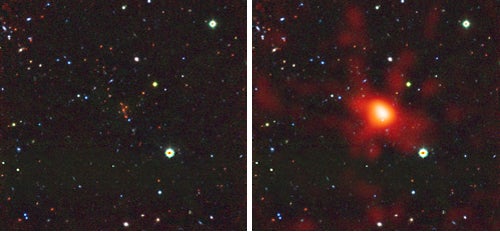Astronomers have detected a galaxy cluster that formed when the universe was less than one-third its current age, making this the earliest mature object astronomers have observed. This finding adds yet another question to the structure formation hierarchy, concerning what objects formed first — big or small.
The astronomers used archived data from the European Space Agency’s orbiting XMM-Newton X-ray observatory to look for regions of X rays that could indicate the presence of clusters. About one-fifth the material in a galaxy cluster is hot gas. This gas emits X rays, which makes looking for X rays the best way to detect clusters.
The team, led by Christopher Mullis from the University of Michigan, saw a faint concentration of X rays — 280 photons in about 12 hours — in the background near the galaxy NGC 7314. The team’s findings are in the February 21, 2005 Astrophysical Journal.
They then used the European Southern Observatory’s Very Large Telescope (VLT) to look at the region in the visible wavelengths. The team found 12 elliptical galaxies in the same region as the X-ray emission, confirming a galaxy cluster’s existence, now named XMMU J2235. The galaxies are composed of old, red stars, and the cluster is spherical, indicating the cluster is an old, mature structure.
The team again used the VLT, but this time to look at the individual galaxies’ spectrums. From this information, they could look at the galaxies’ redshift — in other words, their distances from us.
All 12 galaxies show a redshift of roughly 1.4, which corresponds to about 9 billion light-years. The universe, according to the most precise approximation to date, is 13.7 billion years old. Hence, the observed cluster is from when the universe was close to one-third its present age.
“We are quite surprised to see that a fully-fledged structure like this could exist at such an early epoch,” says Mullis. The earliest known cluster, before this finding, was 500 million light-years younger.
Given the relative ease of discovering the cluster, astronomers expect more such discoveries in the near future.










